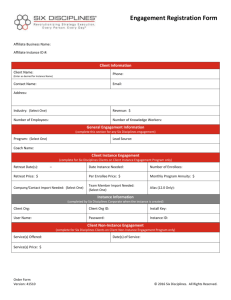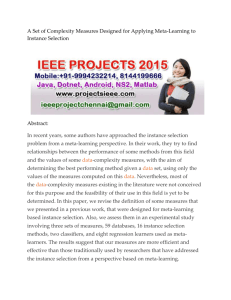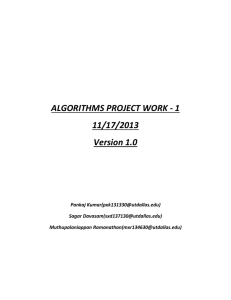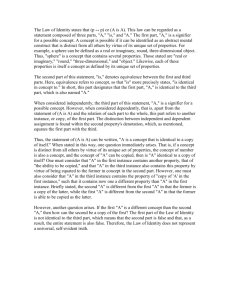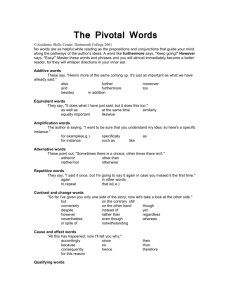comp4_unit5e_audio_transcript
advertisement
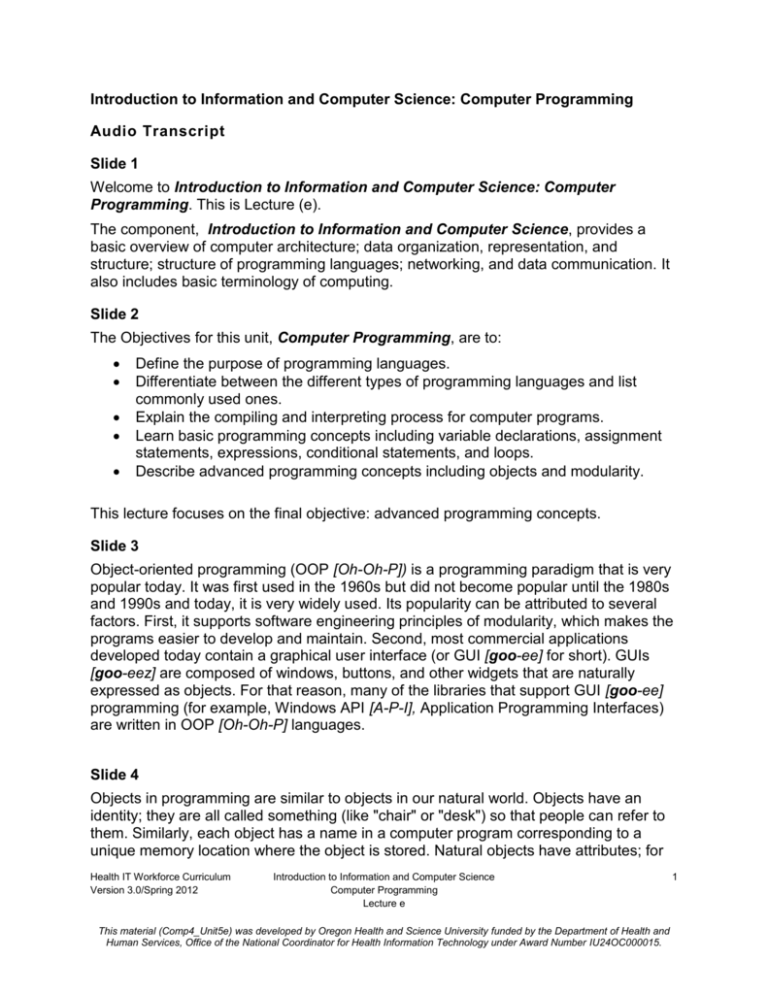
Introduction to Information and Computer Science: Computer Programming Audio Transcript Slide 1 Welcome to Introduction to Information and Computer Science: Computer Programming. This is Lecture (e). The component, Introduction to Information and Computer Science, provides a basic overview of computer architecture; data organization, representation, and structure; structure of programming languages; networking, and data communication. It also includes basic terminology of computing. Slide 2 The Objectives for this unit, Computer Programming, are to: Define the purpose of programming languages. Differentiate between the different types of programming languages and list commonly used ones. Explain the compiling and interpreting process for computer programs. Learn basic programming concepts including variable declarations, assignment statements, expressions, conditional statements, and loops. Describe advanced programming concepts including objects and modularity. This lecture focuses on the final objective: advanced programming concepts. Slide 3 Object-oriented programming (OOP [Oh-Oh-P]) is a programming paradigm that is very popular today. It was first used in the 1960s but did not become popular until the 1980s and 1990s and today, it is very widely used. Its popularity can be attributed to several factors. First, it supports software engineering principles of modularity, which makes the programs easier to develop and maintain. Second, most commercial applications developed today contain a graphical user interface (or GUI [goo-ee] for short). GUIs [goo-eez] are composed of windows, buttons, and other widgets that are naturally expressed as objects. For that reason, many of the libraries that support GUI [goo-ee] programming (for example, Windows API [A-P-I], Application Programming Interfaces) are written in OOP [Oh-Oh-P] languages. Slide 4 Objects in programming are similar to objects in our natural world. Objects have an identity; they are all called something (like "chair" or "desk") so that people can refer to them. Similarly, each object has a name in a computer program corresponding to a unique memory location where the object is stored. Natural objects have attributes; for Health IT Workforce Curriculum Version 3.0/Spring 2012 Introduction to Information and Computer Science Computer Programming Lecture e This material (Comp4_Unit5e) was developed by Oregon Health and Science University funded by the Department of Health and Human Services, Office of the National Coordinator for Health Information Technology under Award Number IU24OC000015. 1 example, a chair has attributes like height, color, and position. Objects in programs have data associated with them called instance variables. Finally, objects have behavior; behavior means “the things that objects can do”. Most people do not necessarily think that a chair has behavior, but it does—it supports the person sitting in it. Similarly, objects in programs have behavior—these are the methods that are defined for the object. OOP [Oh-Oh-P] is just one of many programming paradigms. It is one way of expressing a program for a given problem, but it is certainly not the only way. It is helpful to think of OOP [O-O-P] as a way of organizing a program so that the data and related methods are stored together. This particular type of organization allows for code reuse, both because it is modular but also because it allows for something called inheritance. Inheritance means that objects or classes inherit data and/or methods from other classes. This allows for less code redundancy. Slide 5 It is important to understand some terminology with respect to objects. Objects are not created until a program runs. Writing code for objects involves classes. Classes are the code definition for objects and are considered the blueprints for an object. When a class is used—meaning an object of a class is created—the class instantiates that object. It is similar to declaring a variable except that the data type is the class type, instead of a primitive type for a variable. Slide 6 Here are two different ways to write a code segment that calculates the area of a circle. The left presents a procedure that has been defined to do this. It has an input parameter for the radius and returns the calculated value of the area (pi [pie] times radius squared). On the right side of the slide is a class that has been defined for a circle. It has an instance variable that stores the radius and has two methods—one to set the value of the radius and one to calculate the area of the circle. Note that the “calculateArea” method does NOT need any input parameters since it stores the value of the radius in the instance variable. From this example, it is not clear that either approach is better than the other. But suppose it is necessary to add a method that will calculate the circumference of the circle. To implement the procedural programming approach, add another procedure for the circumference calculation. Once again, it would be necessary to have an input parameter for the radius (or diameter). For the OOP [O-O-P] approach, just add another method to the Circle class. Nothing else would need to be changed, and this method would not need input parameters since it would use the value of the instance variable radius in the calculation. To calculate both the area and circumference of the same circle (i.e., for the same radius), it probably makes more sense to program the solution using the Circle class. This would store the two methods together along with the radius. Health IT Workforce Curriculum Version 3.0/Spring 2012 Introduction to Information and Computer Science Computer Programming Lecture e This material (Comp4_Unit5e) was developed by Oregon Health and Science University funded by the Department of Health and Human Services, Office of the National Coordinator for Health Information Technology under Award Number IU24OC000015. 2 Slide 7 OOP programs are often designed using tools such as Unified Modeling Language (UML [U-M-L]). A UML diagram gives the basics about the class—the name; the attributes (instance variables); and the methods. This is very useful when building a design with all the classes in a program. It gives a snapshot of how the different classes are related and what they do. On the right of the slide is an example design for a class called “BMICalculator.” In this class, assume three instance variables—doubles that store the weight, height, and BMI (body mass index) for the class. Now, assume the following methods for this class: “setWeight” (sets the value of the weight instance variable) “setHeight” (sets the value of the height instance variable) “calcBMI” [kalk-B-M-I] (calculates the BMI and stores it in the bmi instance variable) “outputBMI” (prints the value of the bmi instance variable to the screen) “outputBMICategory,” which outputs to the screen the weight category for the BMI that is stored in the instance variable Important note: This design is NOT for the program written in the previous two lectures for calculating BMI. That program was a simple program that did not include any classes with instance variables and methods (just a class with a main method). Instead, this is what a class might look like if a class were to be used for calculating BMI. Slide 8 Inheritance is a very powerful feature of OOP [O-O-P]. It allows us to define classes based on the definitions of other classes. Classes can inherit methods and/or instance variables from another class. This allows for a lot less code redundancy because it defines instance variables and methods for a class that can be included in many other classes without having to rewrite them in the other class definitions. Another powerful feature of inheritance is polymorphism. This is a concept that is difficult to understand in the abstract; the basic idea is that the same method call will trigger different methods to run, based on the class type of the object. It is not necessary to understand polymorphism at this time, but it is important to know that it is possible with OOP [O-O-P] and inheritance. Slide 9 Here's a sample UML diagram that shows inheritance. In this diagram, the base class or the parent class is the “BankingAccount” class. It has two instance variables defined— one for the account number and the other for the balance of the account. It also has four methods—one to set the value of the account number; another to set the value of Health IT Workforce Curriculum Version 3.0/Spring 2012 Introduction to Information and Computer Science Computer Programming Lecture e This material (Comp4_Unit5e) was developed by Oregon Health and Science University funded by the Department of Health and Human Services, Office of the National Coordinator for Health Information Technology under Award Number IU24OC000015. 3 balance; a third to get the value of balance; and finally, a fourth method to print all the account information to the screen. There are two child classes: “CheckingAccount” and “SavingsAccount.” These two child classes inherit all the methods and instance variables from their parent “BankingAccount,” but they also add more instance variables and methods to their classes. For example, “CheckingAccount” has three instance variables—the two inherited ones from “Banking Account” and one defined specifically for it (overdraft). Similarly, it has six methods—four that it inherits plus the two that are defined for it (“setOverdraft” and “getOverdraft”). “SavingsAccount” inherits the two instance variables from “BankingAccount” and has one additional one—“interestRate.” It also inherits four methods and has two additional methods—“setInterestRate” and “accrueInterest.” The important concept to remember about inheritance is that the base class or the parent class defines instance variables and methods that are inherited by the child classes. This eliminates the need for the child classes to redefine these instance variables and methods in their own classes, which leads to less code redundancy. But, the child classes can also add their own instance variables and/or methods to the inherited ones. In this example, both “CheckingAccount” and “SavingsAccount” have instance variables named “accountNum” and “Balance,” but only “CheckingAccount” has an instance variable named “Overdraft”—“SavingsAccount” does not have this instance variable. Similarly, the “SavingsAccount” class has an instance variable “interestRate” that the “CheckingAccount” class does not. Slide 10 Modularity is the separation of code into separate components. Objects provide modularity in OOP [Oh-Oh-P] languages, but non–OOP [Oh-Oh-P] languages support modularity, too. Procedures, subroutines, and functions are all examples of modules in code. The purpose of modularity is to organize the code into separate components, each of which accomplishes a particular task. This allows for code reuse—the component is defined once but can be called many times. Also, when the program is divided into components, it is easier to maintain. Any changes to one component will have minimal effects on other components. Also, it is easier to identify which code needs modifying since it is separated by function. For example, if the format of a program's output is incorrect, the programmer would know to look at the component that produces output. Slide 11 Encapsulation builds on modularity to provide what is called "information hiding.” Objects can specify whether instance variables and methods are public or private. If they are private, they cannot be accessed directly outside of the class. Typically, instance variables are private and some or all methods are public. When an instance variable is private, it cannot be accessed from outside the class, which prevents other code from changing its value. Instead, the class will provide public methods that can change or retrieve the value of the instance variable. Health IT Workforce Curriculum Version 3.0/Spring 2012 Introduction to Information and Computer Science Computer Programming Lecture e This material (Comp4_Unit5e) was developed by Oregon Health and Science University funded by the Department of Health and Human Services, Office of the National Coordinator for Health Information Technology under Award Number IU24OC000015. 4 When a class or object is well-encapsulated, the details of the implementation of the class are hidden from any other code that will use that class. Also, instance variables can be changed and accessed only by the public methods of the class. These public methods control what valid values are for the instance variables and when the methods can be called. If the variables were public and could be modified by any code, there would be no guarantee that the values were valid. For example, if there is an instance variable of a well-encapsulated class that is used as the denominator of a fraction, the methods that set this value could ensure that it was never set to zero. If the class were not well-encapsulated—say, the instance variable was public and could be changed by any code—there would no longer be a guarantee that the instance variable was not zero. Any other code that uses this class accesses only what is called the interface of the class. This interface is made up of the public methods of the class and any documentation about the class. When accessing the interface, the focus is on only the details needed to use the class, not on how the class is implemented. Slide 12 This concludes lecture (e) of Computer Programming. This lecture introduced object-oriented programming and concepts such as inheritance, modularity and encapsulation. The lecture also described the differences between classes and objects. Slide 13 This also concludes the unit Computer Programming. This unit presented the purpose of programming languages, the different types of programming languages, how a program is compiled or interpreted, what common programming language constructs are (particularly in Java and what OOP [Oh-Oh-P] is. This unit also offered an understanding of how programs are designed and implemented, what code looks like, and what objects are and why they are used. Slide 14 References slide. No audio. Health IT Workforce Curriculum Version 3.0/Spring 2012 Introduction to Information and Computer Science Computer Programming Lecture e This material (Comp4_Unit5e) was developed by Oregon Health and Science University funded by the Department of Health and Human Services, Office of the National Coordinator for Health Information Technology under Award Number IU24OC000015. 5


